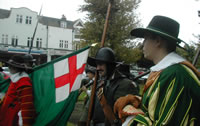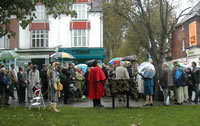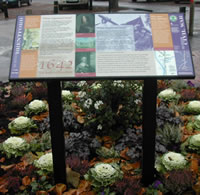Crowds Turn Out To See Launch of Battlefield Trails
As War Walks historian Professor Richard Holmes unveils new information panels
Despite pouring rain, over 160 people watched “War Walks” historian, Professor Richard Holmes, unveil the first of the new information panels outside the Syon Park Garden Centre on Sunday morning. And another 70 were at Turnham Green Terrace to see him unveil another panel by the E3 bus stop the same afternoon.
On both occasions, representatives of the sponsoring societies were accompanied by soldiers and camp followers from Colonel John Hampden’s Regiment. Their drummer set a dramatic note and the troops drilled and fired their muskets over the crowd. After the unveiling at Turnham Green, they led most of the crowd round to Acton Green to see another panel there.
 The Heritage Lottery Fund (HLF) awarded a grant of £15,000 to the Battle-fields Trust to create the trails across the Civil War battlefields of Brentford and Turnham Green and improve local understanding of these events of November 1642.
The Heritage Lottery Fund (HLF) awarded a grant of £15,000 to the Battle-fields Trust to create the trails across the Civil War battlefields of Brentford and Turnham Green and improve local understanding of these events of November 1642.
Research during the project revealed that the Battle of Turnham Green, which was quite a restrained event, was in fact the third largest battle on British soil, with around 36,000 troops participating. And the experts believe that the fact that these battles prevented the King’s troops from marching on London meant that he was not able to retake the capital throughout the whole of the Civil War.
 The project has involved talks and guided walks in Brentford and Chiswick, consultation with a variety of groups, including a youth group in Brentford, the production of 6 information panels (3 for each battle) and a free full colour information leaflet. This trail leaflet will be available shortly in local libraries, museums and other venues – for example, the Barley Mow pub, which stands where the Parliamentarian front line was in 1642, has already taken a batch of leaflets for its customers.
The project has involved talks and guided walks in Brentford and Chiswick, consultation with a variety of groups, including a youth group in Brentford, the production of 6 information panels (3 for each battle) and a free full colour information leaflet. This trail leaflet will be available shortly in local libraries, museums and other venues – for example, the Barley Mow pub, which stands where the Parliamentarian front line was in 1642, has already taken a batch of leaflets for its customers.
To complete the project, the trail leaflet, the full text of the information panels and new educational resources will be added to the Battlefields Trust website over the next few months.
The Brentford and Chiswick Local History Society, Hounslow Heritage Guides, The Duke of Northumberland and Syon Park Estate and the John Hampden Society have all participated in the project.
Background to the Battles
At the beginning of the English Civil War in 1642 the royalists attempted to end the conflict quickly by capturing London. Their advance, under King Charles I, was checked by the parliamentarian army commanded by the Earl of Essex at the battle of Edgehill in Warwickshire on 23 October. The outcome was inconclusive, but the royalists were able to resume their march, occupying Oxford and Reading before advancing along the Thames valley. Essex’s army returned to London.
Parliament sought peace with the King and believed an agreement for negotiations had been reached. But early in the morning of 12 November the royal army, commanded by General Patrick Ruthven, marched via Hounslow toward London. The royalists attacked a small parliamentary detachment at Brentford and, whilst they defeated this force, their advance on London was delayed, enabling parliament to prepare its defence.
The next day the royal army of 12,000 advanced to Turnham Green, to find the road blocked by 24,000 parliamentarians, including the London militia and volunteers. Following some skirmishing and an aborted parliamentary attempt to outflank the royalist position, the King realised he had no chance of pressing on to London and retreated to Oxford.
The battles at Brentford and Turnham Green are overlooked and yet they represent a defining moment in the development of democracy in England. They were the closest the royalists ever came to taking London (and winning the war) during the first civil war. Brentford made many in parliament realise the King would not negotiate a peaceful settlement and a war was inevitable. For numbers involved, Turnham Green is arguably the third largest battle on British soil.
November 5, 2007
